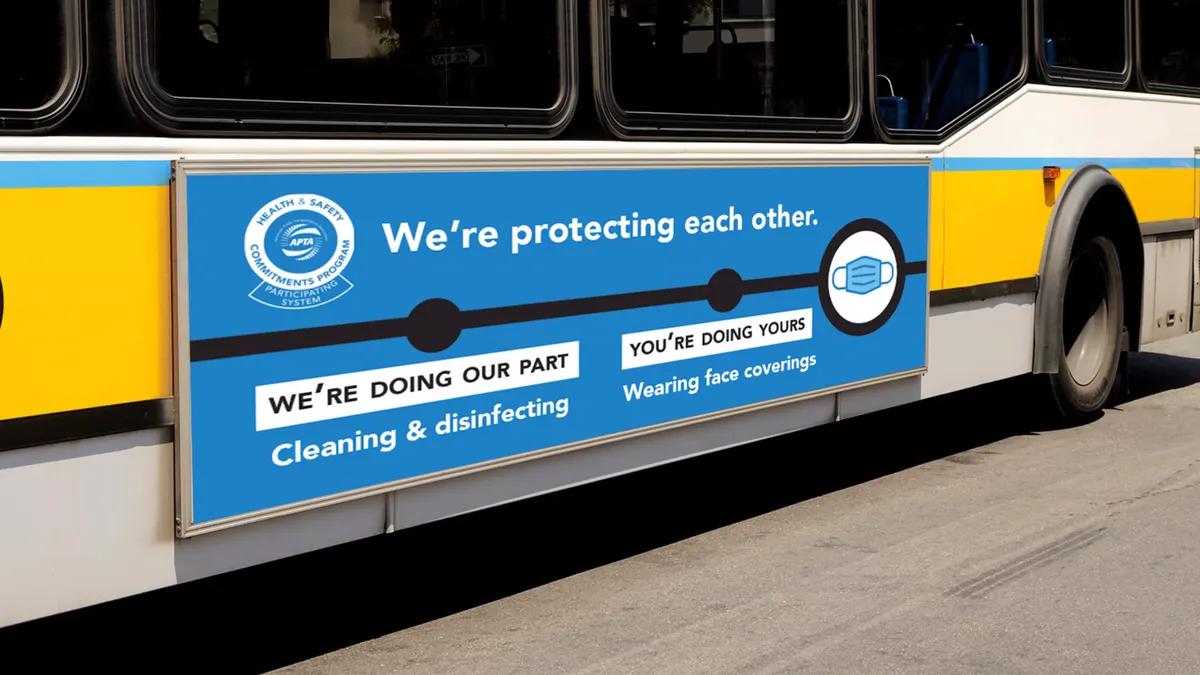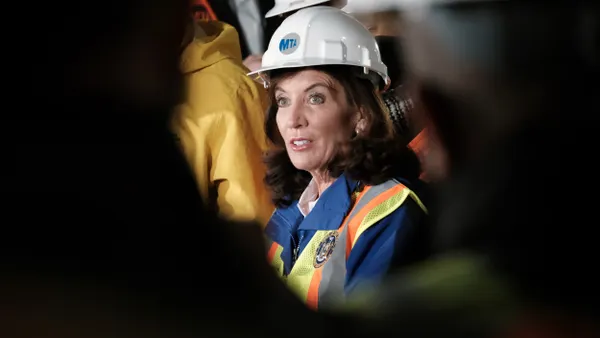Dive Brief:
- The American Public Transportation Association (APTA) unveiled on Wednesday a national Health and Safety Commitments Program to streamline the industry's COVID-19 response efforts and set a cohesive strategy for boosting transit ridership amid recovery.
- The program centers on four key goals: following public health guidelines; requiring riders and employees to avoid public transit if they may be ill with COVID-19; cleaning and disinfecting transit vehicles/stops and enforcing face mask compliance; and keeping passengers informed with transit updates.
- As of its launch, more than 100 public transit agencies have signed on to the program. Agencies that pledge to meet these goals are to display a "seal" on their transit vehicles and stations to indicate their commitment to health and safety to riders.
Dive Insight:
For months, transit agencies nationwide have been "hemorrhaging money" as revenues plummet due to low ridership and moves to eliminate fares for essential workers. The industry received $25 billion in funding through the coronavirus relief bill in late March, but leaders say that money barely scratched the surface of the support needed across all of public transit.
In late July, APTA called on Congress to provide the industry with at least $32 billion in additional emergency coronavirus relief funding, citing an internal study that found nearly one-third of agencies are pursuing or considering employee furloughs.
This latest program from APTA, born of the association's Mobility Recovery and Restoration Task Force, is a "logical extension" of the industry's efforts to mitigate COVID-19 and makes the call for funding "that much more urgent and critical," said APTA CEO Paul Skoutelas.
A number of APTA and transit agency officials joined Skoutelas on Wednesday in a virtual event to kick off the commitments program. LA Metro CEO Phil Washington, who chairs the task force, said on the call that work on this program began when his team was tasked with determining how to help riders "return to using transit systems with confidence." So they reached out to those who would know best: the riders.
The task force collected a number of actions that riders said they'd like to see public transit agencies take amid COVID-19 recovery, including face mask requirements; physical distancing requirements; and frequent cleaning of all transit spaces including HVAC systems. The riders also suggested a seal of some kind to help the public identify the agencies adhering to these practices.
"These findings led us to create the [program]," Washington said. For these commitments to be effective, all stakeholders — riders, employees and the communities they serve — must take actions that align with the goals of APTA, Washington added.
"In all the tools we've prepared for the program, the message you'll see most often is, we're all in this together — and we are," Washington said. "We need a shared sense of purpose to succeed."
In developing the program, officials created a toolkit with a "wide array" of information and marketing materials that agencies can use or create to share its commitment with riders, said Joanna Pinkerton, president and CEO of the Central Ohio Transit Authority and co-chair of the task force.
"We were very careful in the material and the information we’ve provided ... particularly knowing that not all of them have deep pockets when it comes to a marketing budget," she said.
And as for the agencies that do commit to this program, it will be key to maintain transparency and information-sharing to regain trust with riders, said Bacarra Sanderson Mauldin, CEO of the Chatham Area Transit in Savannah, GA.
"COVID-19 moved the transit industry from business as usual to business very unusual," Sanderson Mauldin said. She explained that when her agency first began implementing COVID-19 response strategies, "we heard a few complaints here and there, [but] we were determined to move the message forward."
"We communicate, communicate and communicate," she said.











